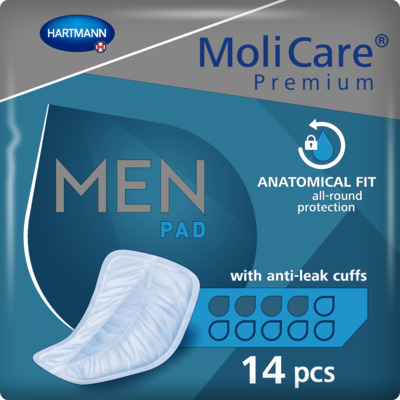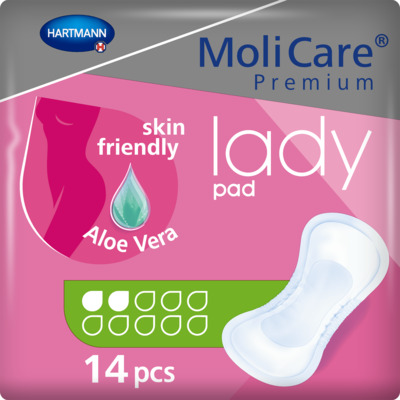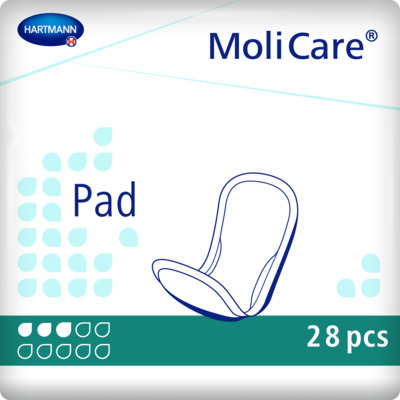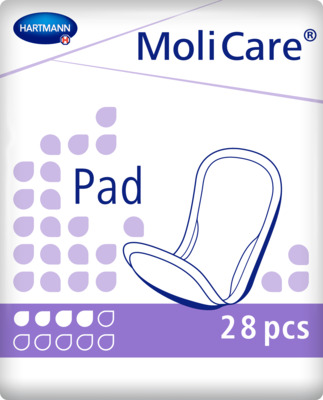Incontinence Advice
Overactive Bladders - Symptoms, Causes, and Treatment Advice
An overactive bladder (OAB) can disrupt daily life with sudden, uncontrollable urges to urinate and frequent nighttime awakenings. Men and women of different age groups can be vulnerable towards an overactive bladder, due to the wide range of causes that can trigger it. In this article, we will look at what is an overactive bladder, the various causes, symptoms, and treatment options available, and how you can make changes in your lifestyle to ease and control an overactive bladder.

What Is An Overactive Bladder? (OAB)
Overactive bladder (OAB) is a common condition that affects millions of people worldwide. It's not a disease but rather a syndrome characterised by the urgent need to urinate, frequent urination during night and day, and in many cases, urge incontinence. This urge can disrupt daily life, affecting everything from work to sleep.
Overactive Bladder symptoms
Those living with OAB often experience a variety of symptoms that can impact their quality of life significantly:
Urgency incontinence: A sudden, intense urge to urinate that is difficult to control (8 times or more within a 24-hour period)
Frequency in urination: Needing to urinate more often than usual, typically eight or more times in 24 hours.
Nocturnal enuresis: Waking up multiple times at night to urinate.
- Urge incontinence: Losing urine involuntarily following a strong urge to urinate.
Coital incontinence: Leaking fluids during sexual activity.
Stress incontinence: When coughing or sneezing adds pressure to the bladder, adding great struggle to urinate.
This frequent, uncontrollable urination can lead to stress, embarrassment, and social isolation.
Causes of an overactive bladder
The exact cause of OAB is not always known, but several factors can increase the risk of developing this condition:
Neurological disorders: Conditions like having a stroke and multiple sclerosis can interfere with nerve signals involved in bladder control.
Urinary Tract Infections (UTIs): These can exacerbate or mimic the symptoms of OAB.
Enlarged prostate: In men, an enlarged prostate can obstruct the flow of urine, leading to symptoms of OAB, as well as other prostate problems.
Pelvic muscle disorders: Weakness or spasms in pelvic muscles can compromise bladder control.
Medication side effects: Some drugs can exacerbate or contribute to the symptoms of OAB.
Physical obstructions: An enlarged prostate or constipation can restrict urine flow, intensifying the urgency and frequency associated with OAB.
Whilst causes of OAB are not always clear, certain symptoms could symbolise something more significant. Hormonal changes, especially during menopause, can affect bladder control, and undiagnosed diabetes can manifest as frequent urination. Knowing about managing incontinence during menopause, and even the correlation between diabetes and incontinence, are crucial to know here, because if left untreated, incontinence in later life can often lead to something worse.
Understanding the Urinary Tract and Overactive Bladder
The urinary tract plays a critical role in waste removal from the body. Here's how it works:
Kidneys: These two bean-shaped organs filter waste from your blood and convert it into urine.
Ureters: Thin tubes that carry urine from the kidneys to the bladder.
Bladder: A muscular sac that stores urine until you're ready to urinate.
Urethra: The tube that allows urine to exit the body. It includes a sphincter muscle that controls the flow of urine.
In a normal cycle, the brain signals the bladder to contract when it becomes full, pushing urine out through the urethra.
Complications from Overactive Bladder
OAB can significantly affect daily life by causing:
Social withdrawal.
Sleep disruption.
Emotional distress.
Risk factors
Several factors can increase the likelihood of developing an overactive bladder (OAB), with age and gender being prominent ones. Women are particularly susceptible due to their anatomical differences and life changes such as menopause.
Neurological conditions like stroke and Alzheimer's disease also heighten the risk because they can impair the body's ability to recognise the need to urinate. Additionally, individuals with diabetes or those who have suffered a stroke might experience worsened symptoms due to their impact on nerve functions and bladder control.

Lifestyle changes for Overactive Bladder management
There are various solutions available on how to treat overactive bladders:
Dietary adjustments
Managing an overactive bladder (OAB) often starts with what you eat and drink. Certain substances can irritate the bladder and exacerbate symptoms. To identify triggers, it's helpful to eliminate common irritants from your diet and then reintroduce them one at a time. Foods and drinks that irritate the bladder and bowels include:
Caffeinated beverages such as coffee and tea
Alcoholic drinks
Acidic fruits like citrus
Tomato-based products
Spicy foods
Chocolate (except white chocolate)
Carbonated drinks
Increasing your intake of fibre-rich, bladder-cleansing foods such as oatmeal, whole grains, fruits, vegetables, and beans can also improve digestive health, which in turn can positively impact bladder function, as well as consuming bladder friendly drinks too.
Bladder training techniques
Bladder training can help manage OAB by stretching the time between trips to the bathroom:
Timed urination: Establish a schedule to urinate, for example, every two to four hours, regardless of the urge, to gradually increase bladder capacity.
Delayed voiding: When you feel an urge, delay going to the bathroom for a few minutes, gradually increasing the delay, which can help strengthen bladder control.
Double voiding: After urinating, wait a few moments and then try again to help empty the bladder completely to prevent frequent urges.
Pelvic floor exercises
Strengthening the pelvic muscles is crucial in managing OAB:
Kegel exercises: Regularly tighten and hold pelvic muscles for several seconds before releasing them. This aids in strengthening the pelvic floor muscles that control urination.
Quick flicks: Rapidly contracting and relaxing pelvic floor muscles can help manage sudden urges.
Biofeedback
Using biofeedback can enhance your understanding of how pelvic muscles work and improve your control over these muscles. This technique uses sensors and monitors to provide feedback on the muscle activity, helping you learn to control these muscles better.
Implementing these lifestyle changes can significantly reduce the symptoms of OAB, improve bladder control, and improve overall quality of life. It's important to discuss these strategies with a healthcare provider to tailor them to your specific needs and ensure they are safe and effective for your situation.
When to consult a healthcare professional
Many associate an overactive bladder (OAB) to be a normal part of ageing, but it is not. Symptoms of OAB can significantly impact daily life, causing distress, embarrassment, and interruption to both social and work activities. It’s essential to understand when and why to seek medical advice for managing this condition.
Persistent symptoms: If you frequently experience sudden urges to urinate, increased frequency, nighttime awakenings (nocturia), or involuntary urine leakage (urge incontinence), it's advisable to consult a healthcare provider.
Impact on daily life: When symptoms start to affect your quality of life, including your sleep, social interactions, and emotional well-being, professional guidance can make a difference.
Beyond discomfort: Although many might feel embarrassed to discuss bladder issues, healthcare professionals are equipped to offer both support and solutions that improve symptoms and life quality.
Diagnostic tests for Overactive Bladder
To accurately diagnose overactive bladder, healthcare providers may recommend several tests:
Urinalysis: This basic test checks for signs of infection, blood, or other abnormalities in the urine.
Urodynamic testing: Measures the bladder's ability to empty steadily and completely, assessing bladder pressure and urinary flow.
Ultrasound: Provides a visual image of the bladder, helping to identify any structural issues or abnormalities.
CT Scan: Offers a detailed, cross-sectional view of the bladder which can help in identifying more complex issues.
Cystoscopy: Involves inserting a scope through the urethra to see the inside of the bladder, allowing doctors to identify any internal issues directly.
Acupuncture: Some studies have suggested that acupuncture can help for treating overactive bladder symptoms, but this in turn can have its pros and cons.
For further information, read the recommended articles:

Learn to combat OAB for a healthier lifestyle
It is important to know that help and support is available if you are suffering from symptoms of an overactive bladder - you can even contact us for information about which incontinence products are right for you. By following our advice, you can experience a comfortable, healthy bladder in no time. Remember: with early recognition and treatment, you can prevent it from worsening.
Incontinence Product Finder
Selecting the right products is key in ensuring security and discretion. If you’re not quite sure what you need, try our product finder. It’ll ask you a few questions about your needs and then provide a list of recommended products that may help you.
Find Product Incontinence Product FinderFAQs
How long does an overactive bladder last?
The duration and intensity of overactive bladder symptoms can vary greatly. Some may experience symptoms that come and go, whilst others may persist for longer. For the most part, it depends of on the personal health management and recommended advice from a healthcare professional.
Does holding urine help overactive bladder?
No, holding urine does not help manage overactive bladder and can actually exacerbate symptoms. It is generally recommended to urinate when you feel the need and to follow a regular schedule.
Does an overactive bladder ever go away?
Overactive bladder is a chronic condition, but symptoms can be managed or alleviated through treatment and lifestyle adjustments. In some cases, symptoms may diminish significantly.
Does drinking water help with overactive bladder?
Drinking water is essential for health, but moderating fluid intake can help manage the symptoms of overactive bladder. It is important not to reduce water intake so much that it leads to dehydration.
Are bananas good for an overactive bladder?
Bananas are beneficial for overactive bladder because they are rich in potassium, which helps regulate muscle contractions and can support bladder health.
What calms the bladder?
Bladder calm can be achieved through various methods including dietary adjustments (avoiding irritants like caffeine and alcohol), bladder training exercises, and certain medications. Pelvic floor exercises can also strengthen the muscles and improve bladder control.
What flares up an overactive bladder?
Common triggers for overactive bladder flare-ups include caffeine, alcohol, acidic and spicy foods, as well as artificial sweeteners. High stress levels and insufficient fluid intake can also exacerbate symptoms.
Sources
Hullett, A., (2024) Is Acupuncture Effective for Treating Overactive Bladder Symptoms? Here’s What the Research Says. Healthline. [online] Available at: https://www.healthline.com/health/overactive-bladder/acupuncture-for-overactive-bladder [accessed 12/06/24]

MoliCare® Premium Men Pad 4 Drops
<h2>Comfortable and absorbent</h2> <p>Why MoliCare for men? Hers are some of the key features of the MoliCare® Premium Men Pads from Hartmann:</p> <ul> <li>Discreet and comfortable</li> <li>Fits the male physique</li> <li>3-layer absorbent core</li> <li>Fast-absorbing system</li> <li>Anti-leakage cuffs</li> <li>Odour neutralisers</li> <li>Wide adhesive strip</li> <li>Skin-friendly</li> </ul> <p>With an affordable price and great quality guarantee, you cannot regret choosing MoliCare® Premium Men Pad 4 drops, equipped with anti-leak cuffs, and 14 pieces per bag.</p> <h2>Slim and discreet under clothing</h2> <p>MoliCare® Premium MEN Pads offer reliable support for men dealing with bladder weakness. Whether it's stress incontinence or urge incontinence, these pads for men are designed to provide a discreet and quick solution on the go. Simply place the pad before applying your underwear and secure it with the adhesive strip for worry-free protection. MoliCare® Premium MEN Pads offer full coverage for men facing very light to moderate bladder weakness.</p> <h2>Leakage protection for men</h2> <p>MoliCare® understands that each individual's incontinence needs are unique. That's why our incontinence products, including MoliCare® Premium MEN Pads, are available in different absorbency levels. You can find the perfect fit and protection for your specific requirements.</p> <h2>Reliable and soft on the skin</h2> <p>Our body-shaped absorbent pads are designed to deliver dependable and skin-friendly incontinence protection every day. Experience discreet comfort with the soft, cotton-like materials and the added benefit of an odour neutraliser, ensuring you feel fresh and confident throughout the day.</p> <h2>Fast delivery to your home</h2> <p>At HARTMANN Direct, we ensure a fast delivery service for all our products. Enjoy free delivery on orders over £50, making it convenient and hassle-free to receive the incontinence products you need. Our dedicated customer care team is here to discuss your incontinence product needs and answer any questions you may have. Call us today on 0800 028 9470 to experience the comfort and confidence that MoliCare® Premium MEN Pads can provide.</p>
MoliCare® Premium Lady Pad 2 Drops
<h2>Skin Friendly Pant Liners</h2> <p>For women that experience slight incontinence and bladder weakness, across different age groups, it can be a challenge to find the right bladder weakness product that is easy to apply and wear without the worry of potential leakages. Fortunately, we understand this approach, hence why we are happy to offer our MoliCare® Premium Lady Pad 2 drops, that is skin-friendly, Aloe Vera applied, and comes with 14 liners per bag.</p> <h2>Slim and discreet liners</h2> <p>Whether dealing with stress incontinence or urge incontinence, these panty liners offer a discreet and easy solution on the go. Simply place the pad in your underwear and secure it with the adhesive strip for all-round protection. Available in different absorbency levels, MoliCare® bladder weakness products cater to all levels of bladder weakness, ensuring secure care.</p> <h2>Control Bladder Weakness</h2> <p>Enjoy the benefits of these body-shaped absorbent panty liners, designed for women with bladder weakness. The pads offer discreet, reliable protection with features including odour control and fast absorption.</p> <p>With a wide adhesive strip, you can comfortably fix the pad in your regular underwear, providing secure and comfortable fixation. The pads are skin-friendly, featuring soft, breathable materials, including foam cuffs, and a top sheet treated with Aloe Vera.</p> <p>Keeping your skin healthy is a priority, which is why MoliCare® Premium Lady Pads have a skin-neutral pH value of 5.5 and an antibacterial finish. They are also dermatologically tested, offering peace of mind.</p> <h2>Buy pant liners online</h2> <p>Never worry about running out with our convenient order service and fast delivery direct to your door. Enjoy free shipping on orders over £50.</p> <p>If you need assistance, our professional customer service team is here to support you in choosing the right product. Reach out to us today at 0800 028 9470 and experience the comfort and reliability of MoliCare® Premium Lady Pads.</p>
MoliCare Pad 3 Drops
<h2>Incontinence pads for men and women</h2> <p>Protect yourself against slight bladder weakness with the MoliCare® Pad 3 drops. Suitable for men and women, offering an ideal solution to regain control and live your active life without interruptions. Slimline, discreet, and contoured to fit your body, these incontinence pads ensure a comfortable and barely noticeable feel, providing exceptional dryness and protection for slight incontinence.</p> <p>Crafted with soft, skin-friendly fabric and a polyester backsheet, these incontinence pads ensure you can confidently go about your day, secure against minor leaks. The wide adhesive fixing strip keeps the pad securely in place, while the super absorbent core wicks moisture away from your skin. The elastic anti-leak edging adds an extra layer of reassurance, and odour neutraliser keeps you feeling fresh and confident. With the MoliCare® Pad 3 drops, you no longer need to let slight or occasional incontinence hold you back from enjoying life to the fullest. Simply adhere the pad to your underwear, and you will barely feel the difference.</p> <h2>Price match promise</h2> <p>Experience convenience with our fast delivery service, bringing your chosen products directly to your door. At HARTMANN Direct, we offer a price match promise and free delivery for orders over £50, making sure you receive both quality and value.</p> <p>If you need further assistance, our customer care team is here to help. Give us a call today at 0800 028 9470, and we'll find the perfect incontinence product tailored to your needs. Take charge of your life with the reliable and comfortable protection of MoliCare® Pad 3 drops. Say goodbye to worries and hello to an active and confident lifestyle.</p>
